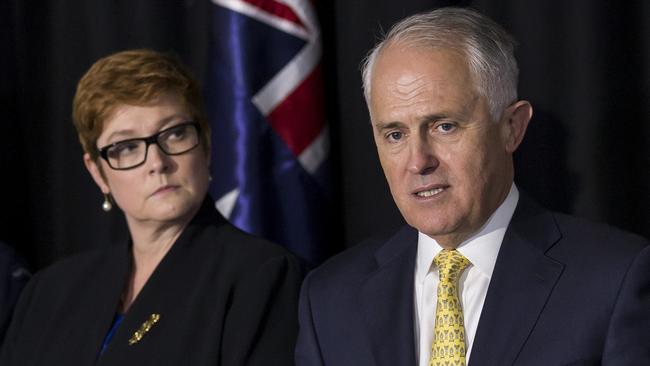Defence white paper: Battle for our slice of $195bn blitz
DECADES of work and billions of dollars — including up to $150 billion for submarines — has been put on the table, setting up South Australia to fight for the biggest share possible.

SA News
Don't miss out on the headlines from SA News. Followed categories will be added to My News.
- Defence White Paper: Future submarines could cost up to $150 billion
- Premier: Defence White Paper ‘an unambiguous win for SA’
- Woomera: Range gets extra bucks for its range
- Analysis: Deadly but very handy toys
DECADES of work and billions of dollars — including up to $150 billion for submarines — has been put on the table, setting up South Australia to fight for the biggest share possible.
The big surprise in yesterday’s Defence White Paper was the confirmation of the cost of major naval projects. The submarines will cost $50 billion to build, and Defence officials and industry experts consistently say acquisition is only one third of the cost.
Theoretically, that puts the whole cost at $150 billion.
As The Advertiserrevealed on Thursday, the Government has committed to 12 submarines, nine future frigates and 12 offshore patrol vessels.
All three projects are going through competitive evaluation processes that will determine how much work and investment will come to SA.
The Government has also pledged to increase Defence spending by $30 billion over the next decade, bringing the total to $195 billion and prematurely meeting the Government’s promise to increase Defence spending to 2 per cent of GDP.
Prime Minister Malcolm Turnbull said the spend was an investment in the economy and in regional security.

“I cannot stress to you enough that the extraordinary growth in our region — of which we have been enormous beneficiaries and which offer us unprecedented opportunities — all of that depends on a stable regional order,” he said.
Defence Minister Marise Payne said the submarine fleet was critical.
“We are an island nation and the core of our maritime strategy, being able to make sure that we are properly equipped to look after ourselves and to work in our region and to work further afield internationally is about making sure we have the right capability,” she said.
The Government is dramatically boosting the Australian Defence Force partly in reaction to China’s antagonism in the South China Sea. The paper also lists terrorism, weapons of mass destruction, and climate change as threats.
Other announcements yesterday include:
AN EXTRA 2500 uniformed personnel taking the ADF staff to 62,400.
LAND-based missiles in the north to target ships, ballistic missiles for the Air Warfare Destroyers, armoured vehicles and helicopters.
$500 million to $750 million to upgrade the Woomera military testing ground in Far North South Australia.
$300 million for cyber hardware and 800 new cybersecurity personnel.
A RANGE of armed, unmanned aircraft — which Air Chief Marshal Binskin said should not be called “drones”, although they commonly are. These could be deployed from the frigates or the OPVs.
The submarine cost is spread over decades, and is an “out turn” cost, meaning the real cost in 2016 dollars is much lower. Senator Payne said yesterday that “you can’t make presumptions” about the sustainment costs.
However, Air Chief Marshal Binskin said the calculation that sustainment is two-thirds of the cost of a military project was used.
“I have used it and in a rough rule of thumb that is but let’s wait and get the rigour to it,” he said.
The Integrated Investment Program accompanying the White Paper says a review in the late 2020s will take into account “the rapid rate of technological change” and strategic circumstances.
That, along with the high cost and the “rolling acquisition” which means the boats will be built in batches, leaves open the possibility of converting them to nuclear partway through.
Senator Payne on Thursday said buying 12 submarines was “entirely consistent within the competitive evaluation process”.

The competitive evaluation process, in which France, Germany and Japan are competing to be Australia’s partner on the submarine project, used eight submarines for planning purposes.
The Coalition was elected on a promise of building 12 submarines in Adelaide, but later backed away from that number saying it was an “aspiration”.
Industry Minister Christopher Pyne said yesterday it was “never” going to be eight.
“The truth is, we were always going to build 12 submarines, and there are 12 submarines in this Defence White Paper. That is an iron-clad guarantee,” he told radio station 5AA.
Premier Jay Weatherill said it was a “win” for the state with a “raft of opportunities”.
“This is what happens when you stand up for SA,” he said. Opposition defence spokesman Stephen Conroy welcomed the plan but said it did not deliver on promises that submarines would be built in SA.
State Opposition Leader Steven Marshall called on his federal counterparts to commit to building all the submarines in SA, saying he has had regular meetings with the Prime Minister and Defence Minister to lobby for Adelaide.
Australian Made Defence said it had been “decades” since the industry had had this much certainty.
National spokesman Chris Burns said while they welcomed the commitment to Defence but wanted confirmation the OPVs would be built in the same place as the Future Frigates — which the Government has said would be built in Adelaide.
“(The Government-commissioned RAND report) outlined that if OPVs were built in the same location as Future Frigates, taxpayers would receive efficiency savings to the price of four free boats. It’s a no-brainer that we should deliver,” he said.


